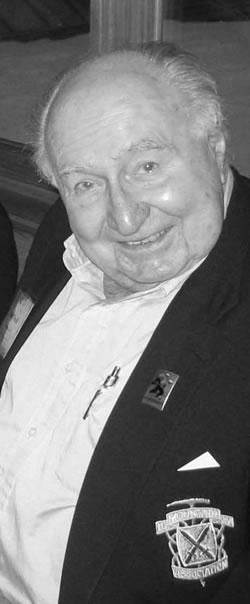Nick Hock - Nick Hock, 10th Mountain veteran and ski industry pioneer
Nick Hock, 91
Nick Hock was born in 1917, and grew up in Grinzing, a western suburb of Vienna, amidst the ruins of the Austro-Hungarian Empire. His father, managing director of a large paper mill, was an accomplished climber, and taught his kids to ski in the hilly Vienna woods. Like his siblings, young Nicholas navigated independently on skis at age four.
Papa Hock saw the writing on the wall. “Austria is finished,” he told his kids daily. “There’s no economic future here. Get out.” They did: Nick’s three older siblings – sister Suzi and the twins Peter and Elizabeth -- settled in Great Britain in the mid-‘30s, and married there. In the spring of 1935, Nick graduated from the local gymnasium, and made plans to go to medical school. But two cousins in London told him that he could make a good living more quickly in the London financial scene. That summer he began an internship in a London investment banking firm. After two years, he moved to another banking job, in Paris. He was there when the Wehrmacht marched into Austria. Nick was now officially a citizen of Nazi Germany, and not happy about it. In November of 1938, he sailed for New York and got a job in the foreign communications department of an investment firm.
When war broke out ten months later, the foreign communications business evaporated. With 25 co-workers, Nick found himself on the street. He went to work selling skis and skiwear for Saks Fifth Ave., replacing his ski racing rival, a young Swiss fellow named Ernie Bloch (later Blake), who had quit to go to work in a boutique called Lanz of Salzburg.
Nick didn’t last long at Saks, either: in June of 1941 he was drafted into the US Army and landed in George Patton’s 4th Armored Division, training at Fort Knox, Kentucky. Immediately after Pearl Harbor, he volunteered for the new 87th Mountain Infantry Battalion and was one of the first of its recruits to arrive at Ft. Lewis, at Christmas, 1941. Assigned to the Mountain Training Group, Nick taught skiing and climbing under the command of Capt. John Woodward and First Sergeant Walter Prager. By 1944, Pvt. Hock had become Sgt. Hock, and was sent to officer candidate school at Fort Benning, Georgia. While he was there, the 10th Mountain Div. sailed for Italy. Lt. Hock caught up with them in Caporetto, at the foot of the Alps, taking command of a heavy weapons platoon in H Company, 87th Regiment, just days before VE Day. The division immediately returned to the US to train for Operation Olympus, the invasion of Japan.
After 56 months in the Army, Nick returned to New York, and to Saks, in 1946. He was soon hired away by DePinna’s, another midtown department store, which wanted a buyer to start a ski department. The winter of 1947-48 was a dry one, so the new department failed. Nick went to work selling ads for the new magazine Ski Illustrated.
It was the start of a long and distinguished career in publishing. By 1950 Nick was selling ads for the Geyer Publishing Co., with trade titles like Office Management and Sports Age. For Sports Age, Nick launched a column on ski retailing. He perceived the need for a ski industry trade show, and sold the idea to the impresario J. Andrew Squires; thus was born, in the spring of 1952, the first National Wintersports Show, in New York. It would evolve into today’s Las Vegas SIA Show.
By 1960, Nick was ad director of Ski Life, where he also founded Ski Business. When, in 1962, Ski Life was consolidated into Ski Magazine, Nick became ad director for the new enterprise. And in 1964 he moved to Ziff-Davis Publishing, as ad director of Skiing Magazine.
In 1969, Nick joined the nascent Lange Corp. in Broomfield, Colo., as director of advertising and sales promotion. He stuck around until Bob Lange lost control of the firm in 1972. Among his accomplishments was the infamous poster, produced by photographer Norm Clasen, of the reclining blonde dressed in a red union suit and Lange boots. Nick winced when he first saw it, then detuned the message a bit by moving the words “soft inside” to a position under the boots.
After working briefly on the Inex binding, in January of 1973, Nick returned to New York as publisher of Ski Magazine. Nick’s strength as a seller of ads and of magazines lay in his close friendship with practically everyone in the ski business. His 10th Mountain contacts, and close relationships with New York’s retail community, meant that he was very successful in placing friends in key sales and marketing jobs. And he had a bottomless supply of truly funny jokes, not all of them bawdy. He was the jolliest fellow on Madison Avenue.
Nick “retired” in 1982, but only from the daily commute in from Connecticut. In leaving Ski, he purchased the trade magazine Ski Business, and published it successfully for ten years. Then he sold it to The New York Times Co.’s Snow Country division and retired for real.
Nick died Nov. 1, 2008, in Woodstock, Vermont, of complications due to diabetes. –Seth Masia
